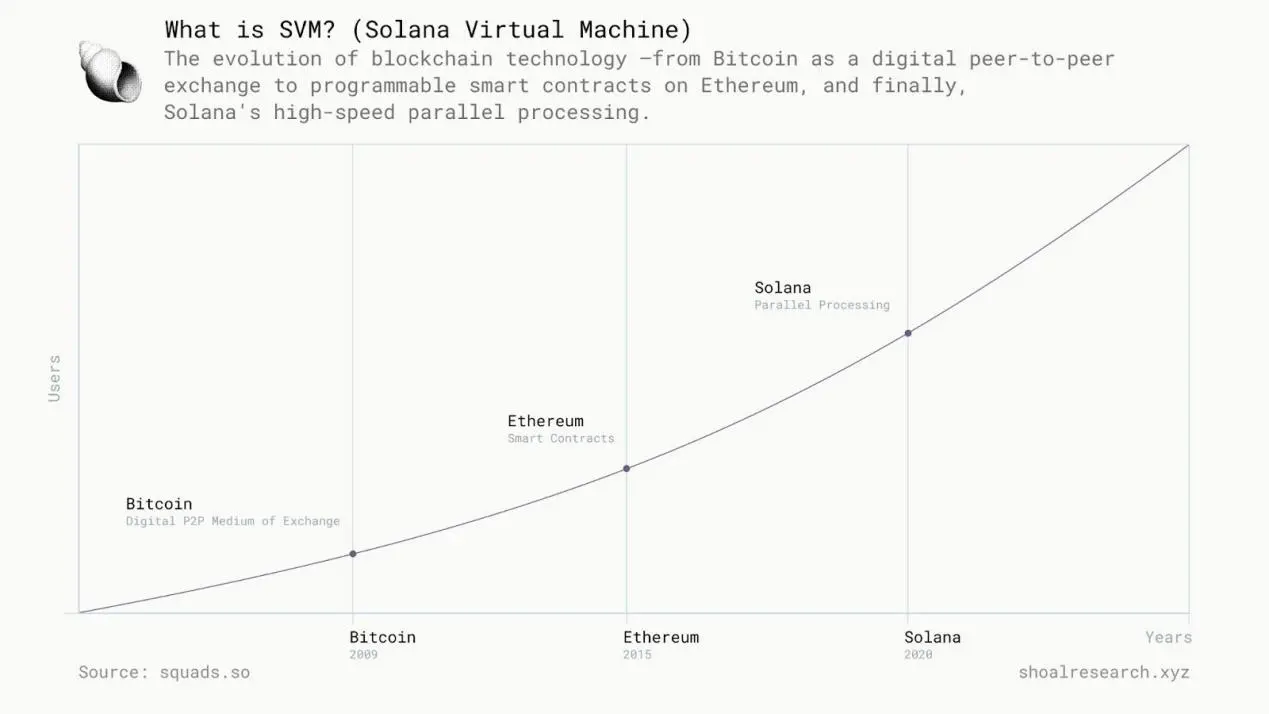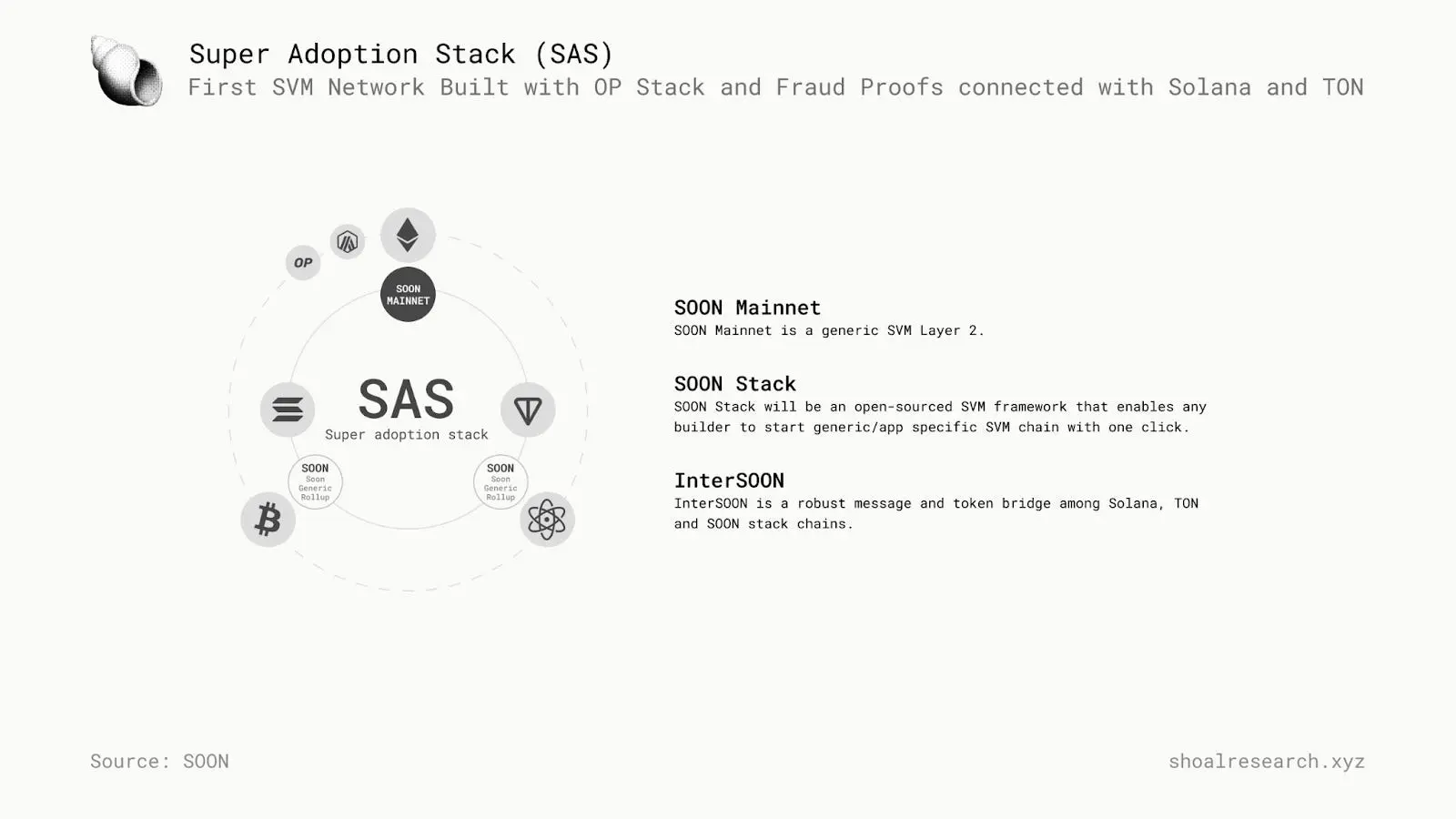SOON Network: Expanding SVM beyond Solana | Very early project attention
Author: Scof, ChainCatcher
Edited by TB, ChainCatcher
After the Pump wave, the Solana ecosystem needs to build more valuable projects to retain users and continue to expand the influence of its ecosystem.
But how to get more users in the ecosystem to use the fast and low-cost Solana chain?
SOON Network stands out as a rollup stack designed to deliver top-tier performance to all Layer 1s, with an architecture tailored to meet the high-performance demands of modern decentralised applications.
Project Introduction
SOON Network is the first protocol to utilise Decoupled SVMs, aiming to expand Solana's execution capabilities beyond its native ecosystem. SOON builds high-performance Layer 2 solutions through SVM-based rollup solutions and settles on mainstream Layer 1 networks like Ethereum, providing better scalability, low transaction costs, and efficient developer experience.

Decouple SVMs to expand Solana execution capabilities
The blockchain industry has long faced challenges such as scalability, interoperability, and high transaction costs. Solana uses a parallel execution architecture to achieve high throughput and low-cost transactions thanks to SVM (Solana Virtual Machine). However, the Solana ecosystem is relatively closed, limiting the application of SVM in the broader blockchain ecosystem.
By decoupling SVMs, SOON Network extends Solana's execution capabilities to L1 ecosystems like Ethereum, achieving the following key optimisations:
- Improved Scalability: SVM uses parallel execution, increasing throughput and reducing transaction costs, offering stronger performance advantages over EVM (Ethereum Virtual Machine).
- Enhanced Interoperability: Through the SOON Stack, SOON allows for the deployment of SVM rollups in different L1 ecosystems and enables seamless interchain interaction with the help of the InterSOON cross-chain messaging protocol.
- Optimized developer experience: SOON makes SVM an independently deployable execution layer, enabling developers to freely build dApps without being limited by the Solana ecosystem.
Technical architecture
SOON Network adopts a modular design that improves scalability, interoperability, and developer experience by decoupling SVMs to become a separate execution layer. Its core architecture includes three major components: SOON mainnet, SOON Stack, and InterSOON, which work together to build a high-performance, multi-chain compatible SVM Rollup ecosystem.
- SOON Mainnet
SOON mainnet is the first decoupled SVM rollup to settle on Ethereum and supports seamless cross-chain bridging between ERC-20 and SPL assets. It offers high-performance SVM execution while inheriting Ethereum's security.
- SOON Stack
SOON Stack is a modular rollup framework that allows developers to deploy SVM rollups on different L1 ecosystems, supporting scenarios such as AI, DePIN, and DeFi.
- Multi-L1 support: Ethereum is the settlement layer and integrates data availability solutions such as EigenDA, Celestia, and Avail.
- Custom Rollups: Supports rollup structures optimised for specific applications.
- High-Performance Execution: Decoupled SVM separates the execution layer from the consensus layer, enhancing efficiency.
- InterSOON
InterSOON is a cross-chain messaging protocol in the SOON ecosystem, providing efficient and secure cross-chain assets and smart contract interactions, avoiding liquidity fragmentation issues caused by traditional cross-chain bridges.

Compared to EVM, SVM has significant differences in architecture and performance:
- Execution Mode: EVM executes sequentially on a single thread, while SVM relies on the Sealevel engine for parallel execution, significantly increasing throughput.
- State Management: SVM adopts an explicit state access model to avoid data conflicts and improve execution efficiency.
- Hardware Utilization: SVM takes full advantage of modern multi-core processors through multi-threading, while EVM is limited by single-threaded architectures.
- Fee mechanism: EVM adopts a global fee market and is susceptible to network congestion. SVM uses a localised fee market to reduce gas fees and improve predictability.
Community funding mechanism
SOON employs a community NFT minting model, optimising the early investor experience, ensuring fairness and decentralisation.
- NFT-bound token benefits: Participants acquire tokens by minting NFTs instead of directly purchasing them, and NFTs can be traded to increase liquidity.
- Configurable Pricing and Lock-up: Offers multi-tiered pricing schemes, allowing users to choose high-priced instant liquidity or discounted prices for long-term lock-up, reducing selling pressure.
- Fair Access: No private rounds, all token allocations are transparent, ensuring fair participation for retail users and institutional investors.
Investment and team background
On January 22, 2025, SOON Network completed a $22 million financing, led by Hack VC, with participation from MH Ventures, SNZ Holding, ABCDE Capital, Anagram, and others. In addition, well-known investors Kuai Dong, Kartik Talwar, Mable Jiang also participated.
According to the official website, the team's co-founder and CEO is Joanna Zeng, who was previously the vice president of Aleo and has also worked at Coinbase, OP Labs, Citi, and BNP Paribas. The team also includes former Amazon Web Services developer Nazreen and zkHoldem co-founder and head of marketing Henry Spencer.
(This article only introduces early-stage projects and is not intended as investment advice.) )
